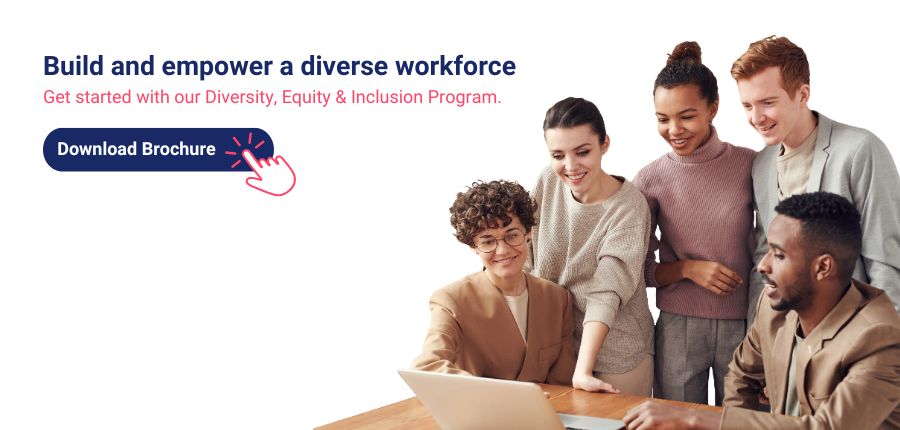Diversity isn’t just a buzzword anymore – it’s a crucial aspect of modern workplaces. Yet, even with this recognition, many companies still grapple with effectively managing a diverse workforce.
Imagine a workplace where a diverse group of skilled individuals, each bringing unique backgrounds, experiences, and viewpoints, collaborate together within a single workspace. While this setup holds immense potential, it also comes with its fair share of challenges.
Let’s start with the numbers! Did you know that, on average, a woman earns 80.7 cents for every dollar a man earns? That’s a stark reminder of the gender pay gap that persists today. And it’s not just about gender – 57% of workers believe that their companies need to be more diverse. These figures paint a clear picture of the current landscape: diversity is recognized as vital, yet there’s room for improvement.
Now, let’s talk about the everyday reality of managing diversity. Imagine a typical workweek – 35 hours of diverse minds collaborating, innovating, and striving towards common goals. It’s an exciting prospect. However, it can also lead to potential conflicts. Without a mindful approach, workplace diversity can inadvertently fuel tensions rather than promote inclusivity.
Communication breakdowns, unconscious biases influencing decision-making, and cultural misunderstandings are just a few examples of the hurdles that companies face when managing a diverse workforce. The problems can slow down work and make it harder for the team to stick together. They can also damage the inclusive atmosphere that companies want to create.
The good news? There are effective strategies and practices that can help navigate these challenges and create a thriving, inclusive work environment. From embracing diverse perspectives to implementing robust communication frameworks, companies have the tools to turn diversity into a strength rather than a source of discord.

Table of Contents:
- Introduction: The Importance of Diversity
- Key Strategies for Effective Diversity Management
- Creating an Inclusive Work Environment
- The Role of Leadership in Promoting Diversity
- Measuring Success in Diversity Initiatives
- Challenges and Opportunities in Managing Diversity
- Conclusion: A Vision for Future Diversity Practices
Overcoming the challenges of a diverse workforce:
With diversity comes a wealth of perspectives, but it also brings its fair share of challenges. Let’s break it down and see how you can address these issues effectively:
Communication quandaries
Communicating effectively in a diverse team can sometimes feel like navigating a maze blindfolded. Language barriers, different communication styles, and generational differences can throw a wrench into smooth collaboration. 65% of the executives surveyed stated that language barriers were present between their companies’ managers/executives and other workers when managing diverse workforces.
Imagine trying to convey a complex idea when English isn’t everyone’s first language, or when slang and technical jargon fly over some heads. it can lead to confusion, decreased productivity, and missed opportunities. So, what’s the remedy? Encourage clear communication channels, offer language training if needed, and promote a culture where everyone feels comfortable expressing themselves without fear of being misunderstood.
Managing the melting pot of opinions
Diversity of thought is a beautiful thing, but when everyone has a different idea and no clear direction, decision-making can turn into a chaotic guessing game. You want to harness the power of varied perspectives while avoiding decision paralysis.
How do you strike that balance? Encourage constructive discussions, guide teams towards consensus, and ensure that innovative ideas don’t get lost in the sea of opinions. Forbes has uncovered that teams with diversity achieve results that are 60% better and make superior decisions in 87% of instances.
Tackling unconscious bias and hostility
Unconscious biases can rear their heads in subtle ways, leading to hostility and distrust among team members. This can sabotage collaboration and stifle creativity.
Leaders need to champion a culture of respect, empathy, and inclusivity to combat biases and build trust. By promoting awareness, providing bias training, and creating a safe space for open dialogue, you can build a more harmonious and productive work environment.
Overcoming diversity implementation hurdles
Implementing diversity initiatives isn’t just about ticking boxes—it’s about understanding each team’s unique dynamics and tailoring strategies accordingly. However, this process can be daunting, especially without strong support from top leadership. A survey by Deloitte institute revealed that 38% of organizations struggle with implementing effective diversity initiatives due to a lack of top-down support.
To bridge this gap, prioritize diversity and inclusion at all levels, garner support from executives, and tailor your approach to fit each team’s needs. remember, diversity isn’t a one-size-fits-all solution.
Striking a balance in talent retention
Retaining top talent is crucial for maintaining a diverse and high-performing workforce. however, this doesn’t mean overlooking underperformance. Leaders should provide growth opportunities while holding all employees to high standards.
By offering coaching, continuous learning opportunities, and regular feedback, you can nurture talent while ensuring that everyone contributes meaningfully to our collective success.
Building an inclusive workplace isn’t without its challenges. But with the right strategies and a commitment to continuous improvement, you can create a thriving environment where everyone feels valued and empowered to succeed.
Here are additional suggestions to help navigate the obstacles posed by a diverse workforce!
Navigating a diverse workforce isn’t about checking off boxes—it’s about creating a thriving, inclusive environment where every individual feels valued and empowered. let’s dive into effective strategies that go beyond buzzwords and drive real change.
Move beyond buzzwords
Diversity isn’t just a trend—it’s a mindset. rather than treating it as a fleeting buzzword, aim to embed diversity, equality and inclusion (DE&I) into the fabric of your company. Make it a daily commitment, just like your sales team pursues leads or your accounting team manages finances.
Align leadership with objectives
For any diversity initiative to succeed, leadership buy-in is crucial. ensure that your leadership team not only supports but actively champions DE&I objectives. Their actions and behaviors set the tone for the entire organization.
Regular policy audits
Periodically audit your company’s policies to root out systemic inequalities. Look for ways to make policies more inclusive, such as offering LGBTQ-inclusive family leave or remote work options for diverse needs.
Develop a forgiving and empathetic culture
Create a culture where mistakes are seen as opportunities for growth, and empathy is the norm. Leaders should model empathetic behaviors, creating a psychologically safe space for all employees.
Address blind spots
Leaders must identify and address their blind spots, such as unconscious biases or communication barriers. Provide coaching and resources to help them navigate diversity challenges effectively.
Implement diversity coaching programs
Offer tailored diversity coaching programs for employees and leaders. These programs promote awareness, reduce biases, and foster inclusive behaviors, creating a shift in mindset towards inclusivity.
In conclusion, managing diversity is not merely a checkbox item on a company’s agenda; rather, it is an ongoing journey that demands steadfast commitment, genuine empathy, and actionable strategies. By integrating Diversity, Equity, and Inclusion (DE&I) principles into the very fabric of your organization and cultivating a culture of inclusivity, you can forge a workplace environment where every individual not only survives but thrives.
One crucial aspect of encouraging diversity and inclusivity is through diversity coaching programs. These programs play a pivotal role in educating employees about the significance of diversity, mitigating unconscious biases, diminishing prejudices, and cultivating a more inclusive mindset. It’s not just about checking boxes or paying lip service to diversity; it’s about instigating a profound shift in how individuals perceive themselves, their colleagues, teams, and workspaces, leading to a more supportive and inclusive atmosphere for everyone involved.
At uExcelerate, we have developed a robust DE&I Coaching Program designed to aid organizations in nurturing diversity, equity, and inclusion within their ranks. To learn more about how uExcelerate can help your organization embrace diversity and inclusion effectively, please reach out to us at [email protected]. Let’s co-create a workplace where everyone feels valued, respected, and empowered to excel.
















